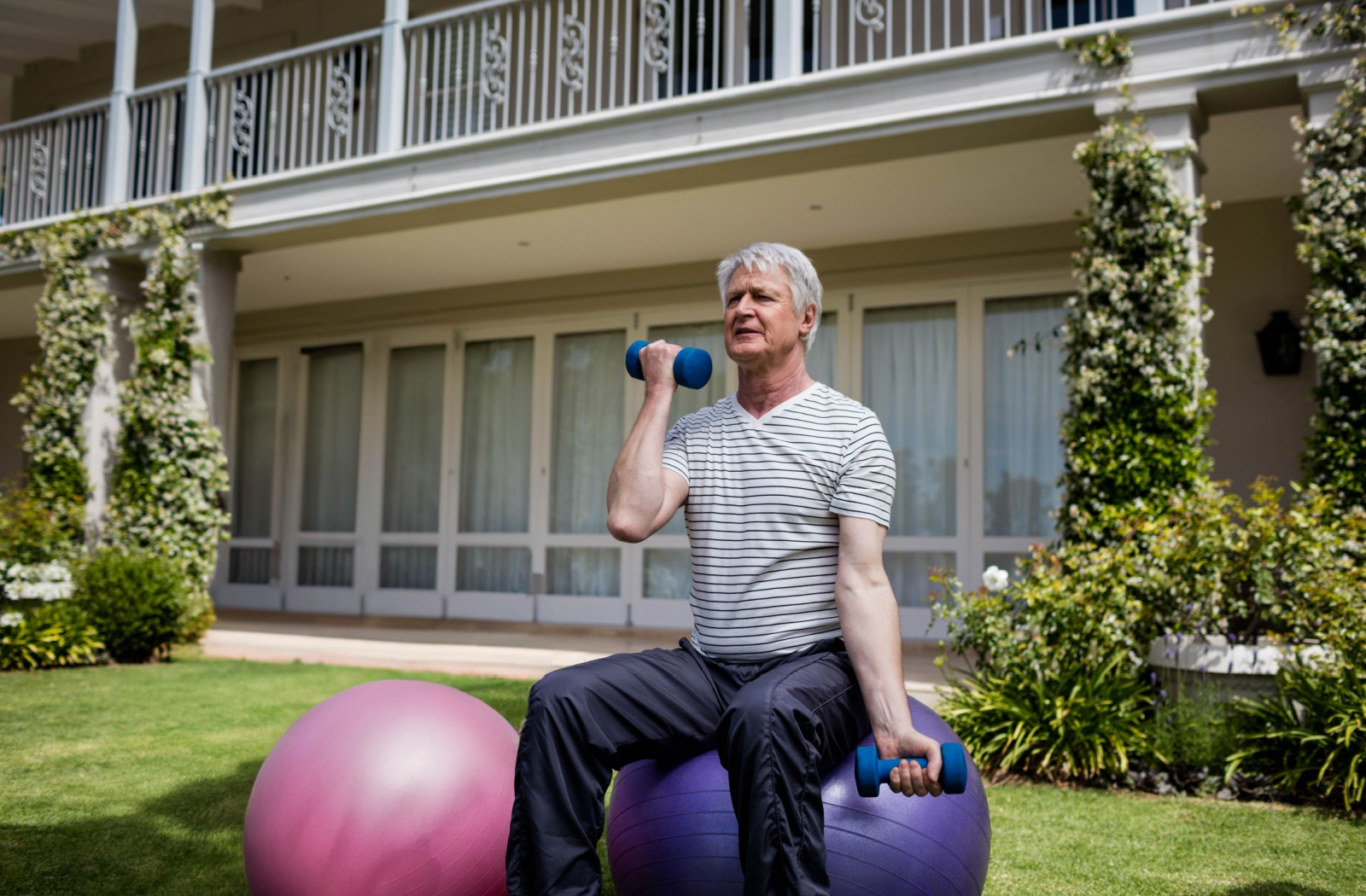Muscle loss may be a natural part of aging, but it doesn’t have to define your later years. While it’s true that our strength tends to decrease over time, there are simple and effective ways to maintain muscle, preserve mobility, and stay active well into your senior years.
With consistent movement, strength-based exercise, proper nutrition, and supportive wellness tools like hydrotherapy and personalized fitness programs, it’s possible to maintain strength, mobility, and independence at any age. These simple habits help seniors feel strong, steady, and energized through every stage of aging—supporting not just physical health, but overall quality of life.
Understanding Muscle Loss in Aging Adults
Starting around age 30, adults begin to lose muscle mass at a slow pace. By the time you reach your 60s or 70s, that process—known as sarcopenia—can accelerate significantly, especially if physical activity is reduced.
It varies from person to person but, you can lose up to 8% of your muscle mass each decade.
Without proper care, this loss of muscle can affect daily function, increasing the risk of falls and making simple tasks more difficult.
Sarcopenia is influenced by a variety of factors, including:
- Reduced physical activity: A more sedentary lifestyle can lead to faster muscle breakdown.
- Nutritional deficiencies: Inadequate protein or calorie intake reduces the body’s ability to build and maintain muscle.
- Chronic health conditions: Joint pain, arthritis, or other limitations can make movement more difficult, compounding the issue.
While muscle loss may be common, it isn’t inevitable. With the right support and a proactive approach, seniors can retain strength and thrive in daily life.
How Muscle Loss Impacts Daily Living
Muscle isn’t just about lifting heavy objects. It plays a critical role in everyday actions—getting out of bed, walking to the mailbox, climbing stairs, or catching your balance.
Some of the key effects of age-related muscle loss can include:
- Higher fall risk: Weakened muscles mean reduced stability and coordination.
- Increased fatigue: Lower muscle mass leads to reduced endurance, making physical tasks more tiring.
- Greater health challenges: Muscle supports bone density, metabolism, and even immune function, so its decline can worsen conditions like osteoporosis, diabetes, and heart disease.
The good news? Muscle responds well to even small improvements in movement and nutrition—at any age.
Long-Term Benefits of Preserving Muscle
Investing in muscle health pays off in many ways:
- Improved mobility and independence
- Better posture and fewer aches
- Reduced fall risk and faster recovery
- More energy and enthusiasm for daily activities
Most importantly, maintaining muscle helps seniors continue doing the things they love—whether it’s traveling, playing with grandchildren, or enjoying a peaceful walk outdoors.
Staying Active to Preserve Strength
Consistent movement is one of the most effective ways to prevent or slow muscle loss. You don’t need to commit to intense workouts to see benefits. Simple, routine activities can help maintain strength and flexibility.
The CDC recommends that older adults perform a minimum of 150 minutes of moderate-intensity activity, 75 minutes of higher-intensity activity each week, or some combination of the 2.
Strength-Based Exercises
Light strength training using bodyweight, resistance bands, or dumbbells helps stimulate and rebuild muscle tissue. Focus on key areas like the legs, core, and upper body.
Gentle Cardio
Low-impact activities like walking, water aerobics, and cycling keep your muscles engaged while supporting heart health and circulation. These are easy to adapt based on mobility and fitness level.
Balance & Flexibility
Programs like yoga and tai chi improve joint range, reduce fall risk, and support muscle function in a low-pressure setting.

Fueling Your Body for Muscle Health
Diet is just as important as exercise when it comes to preventing muscle loss. The right foods provide the nutrients your body needs to repair and grow muscle tissue.
Prioritize Protein
Protein is the building block of muscle. Seniors should aim for protein-rich meals and snacks that include foods like:
- Chicken or turkey
- Fish and seafood
- Beans and legumes
- Greek yogurt or cottage cheese
Spacing protein intake evenly throughout the day also helps maximize absorption.
Emphasize Nutrient-Dense Choices
Include a variety of whole grains, leafy greens, healthy fats (like nuts and olive oil), and antioxidant-rich fruits and vegetables. These support muscle repair and reduce inflammation.
Stay Hydrated
Even mild dehydration can impair muscle performance and increase fatigue. Seniors should aim for consistent fluid intake, specifically at least eight glasses per day, and more when leading an active lifestyle.
More Lifestyle Tips To Support Muscle Health
Beyond food and fitness, a few daily habits can make a meaningful difference in preserving strength:
- Get quality sleep: Sleep is essential for muscle recovery and hormone balance. Older adults need about 7-9 hours each night.
- Manage stress: Chronic stress increases cortisol, which can break down muscle tissue over time.
- Stay connected: Social engagement can improve motivation and reduce the risk of depression—which often leads to physical inactivity.
Preventing Muscle Loss with Holbrook
WellFIT
For those looking to build muscle in a guided environment, WellFIT offers personalized fitness programs tailored to seniors. It combines expert instruction, social motivation, and targeted workouts in a safe, enjoyable space.
HydroWorx
Hydrotherapy offers a unique way to support muscle health through gentle, low-impact movement. At Holbrook Woodstock, the HydroWorx system uses water’s natural buoyancy to reduce joint strain, making it easier and more comfortable to exercise. The built-in underwater treadmill promotes walking and strength training without stress on knees or hips, making it an excellent option for those with arthritis or mobility limitations.
Steady Steps by WellFIT
The Steady Steps Program at Holbrook is a 15-week program aimed to help reduce the risk of falls in participants. A Certified Personal Trainer is by your side for the duration of your program, offering guidance and encouragement every step of the way. Feel confident knowing you have dedicated support throughout your entire journey.
Holbrook Longevity Program
The Longevity Program at Holbrook is a monthly membership designed for individuals seeking consistent, coach-led exercise and movement support. Through personalized 1:1 sessions with a Certified Personal Trainer, participants benefit from functional fitness assessments, progress tracking, and proactive monitoring to support early intervention. With flexible scheduling and a goal-oriented approach, this program is ideal for those looking to stay active, motivated, and engaged in their wellness journey. Our trainers are here to help preserve your mobility, functional strength, and overall quality of life.
The Perfect Place to Lead a Healthier Life
Preventing muscle loss as you age doesn’t mean taking on intense workouts or rigid routines—it means making thoughtful, consistent choices in a community designed to support your goals. At Holbrook Woodstock, residents have access to tools like HydroWorx for low-impact resistance training, and guided programs like WellFIT that combine fitness, education, and motivation in a welcoming, social setting.
Here, wellness is woven into daily life. Whether it’s lifting light weights in a group class, walking with friends on beautiful grounds, or fueling up with nutrient-rich meals at one of the many on-site restaurants, every moment is an opportunity to support strength, independence, and vitality. The result? A lifestyle where aging actively and gracefully is not just possible—it’s celebrated.
At Holbrook Woodstock, living well means living strong. Schedule your visit today and see how we help residents stay mobile, energized, and empowered—every step of the way.
